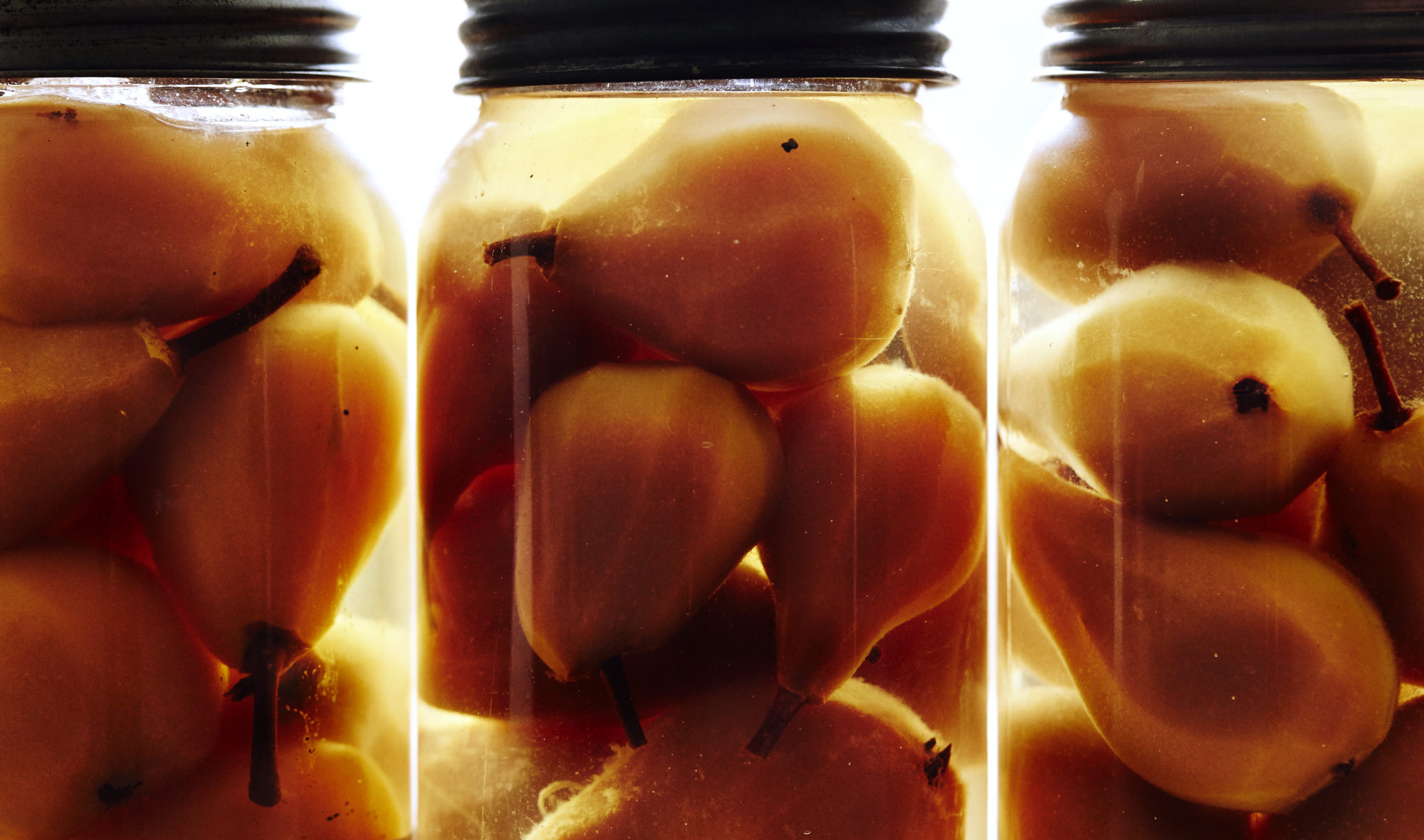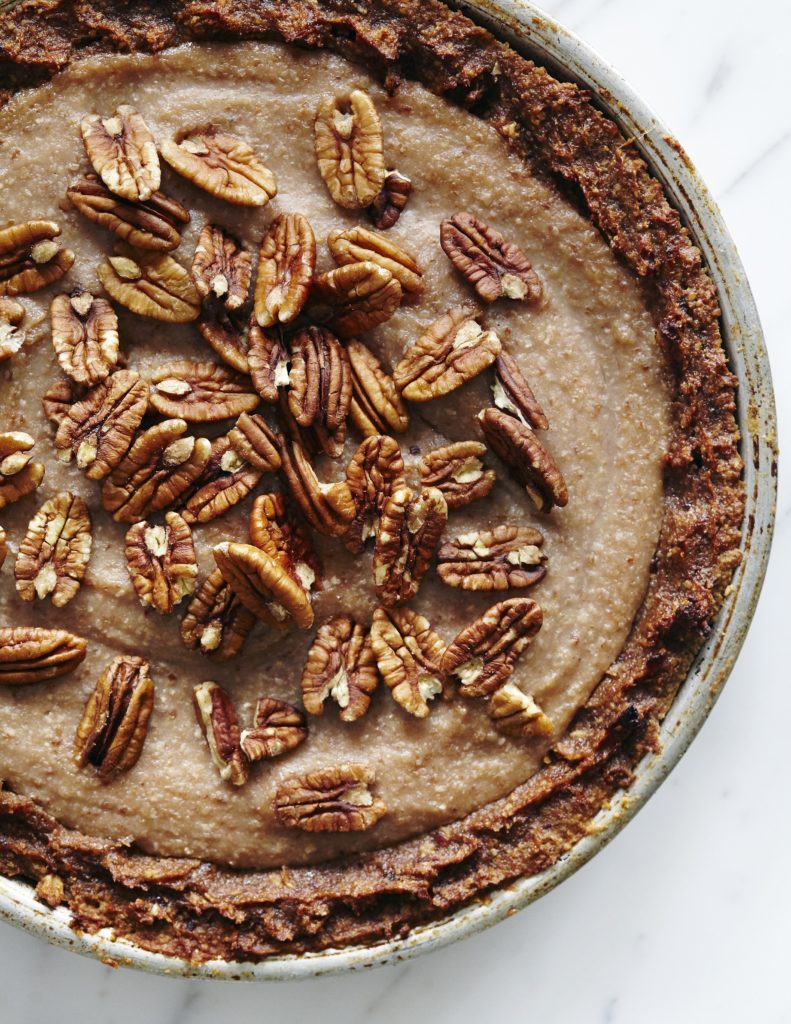
Join PN Level 2 for about $6/day! Plus, FREE Bonus worth $697! (This week only.)

Pears are a fruit that grow on trees, and come into season late summer/early fall. Pears are juicy and sweet with creamy, tender flesh. They’re a good source of fiber, Vitamin C, Vitamin K, and copper. They also offer antioxidant and anti-inflammatory flavonoids, especially in their skin. Allow un-ripe pears to ripen at room temperature; when ripe, pears will yield to gentle pressure. Enjoy them as a snack, add them to salads, soups or roasted vegetable dishes, or use them in baking.
Pears are the fruit of the pear tree (or the genus Pyrus), which grows in cool temperate climates.
Fall is pear season. Some varieties ripen in late summer and stay in season through spring, but in general pears are thought of as an autumnal fruit, known for their tender, juicy flesh, and sweet flavor.
Bartlett and Bosc are probably the most common varieties; they are enjoyed raw or used in cooking and baking. Other types include Anjou, Comice, and the small, squat Seckel variety.
Pears have a distinctive teardrop shape. (Suitably enough, often known as ‘pear-shape.’) Of course, there is some variation among the different pear types: some are short and plump (Seckels), others are longer and leaner (Bartletts), and certain other varieties have more of a rounded, apple-like shape (Nashi, or Asian Pear).
Pears have a thin skin that changes color as the pear ripens; most are greenish when young, then take on a brown, golden and/or reddish color as they mature. The exact colors and markings depend on variety.
On the inside, pears have white flesh with a small core containing brown, teardrop shaped seeds.
One small pear typically has 84 calories, 0.5g of protein, 0.2g of fat, 22.5g of carbohydrates, 4.6g of fiber, and 14.4g of sugar.
Pears are a good source of vitamin C, vitamin K, and copper.
Pears are sometimes cited for their antioxidant properties; this is especially true of pears’ skin, which contains antioxidant and anti-inflammatory flavonoids.
Due to their anti-inflammatory properties, some studies are exploring pears’ ability to decrease risk of diseases like type 2 diabetes and heart disease.
If buying pears from the supermarket, you may find it tricky to find a perfectly ripe pear. This is because pears are often picked well before they are ripe, as they continue to ripen after they are picked. Fortunately, you can pick up firm, unripe pears at the market and allow them to ripen on your countertop until they’re ready to eat.
Because of their tender flesh, pears bruise easily. Avoid pears that have big, noticeable bruises, cuts or dents.
To tell if a pear is ripe to eat, gently squeeze the fruit along its neck. The flesh should yield in response if it is indeed ripe. Alternatively, gently poke your nail into the body of the pear. If your nail easily penetrates the skin, then the pear is ripe; if the pear feels very firm, then it likely needs a bit more time to ripen.
In addition to fresh pears, you may find pears canned or jarred (sometimes with syrup). Pears are sometimes dried, made into jam, or turned into juice. (If buying pear juice, you may wish to choose the ‘cloudy’ type of juice which contains actual pear pulp, as it is known to contain more health benefits than the filtered kind.)
Allow un-ripe pears to ripen on your countertop; this process could take up to several days, depending on the pear’s maturity.
Do not put un-ripe pears in the refrigerator – they will not ripen that way.
Pears, once ripe, should be consumed as soon as possible. You can keep them in the refrigerator to extend their life once ripe, although the longer they sit the more nutrients – and flavor – they may lose. Nonetheless, you can keep them in an open bag in the fruit crisper for about 5 days.
Pears can be eaten out of hand – simply wash and eat the fruit. (Leaving behind its stem and inner core, of course.)
To slice a pear, first cut it in half. Then, using a paring knife or a melon baller, gently but firmly slice or scoop away the core. Place the flat sides of the pear flesh-side down on a cutting board and slice lengthwise according to your desired thickness.
Once you’ve cut into a pear it’s best to eat it soon; otherwise it may start to brown.
Pears can be used in both sweet and savory dishes.
Fresh and raw, they may be added to salads or cheese plates, but pears also respond well to cooking and baking, including savory preparations.
For example, try sautéing pears with leafy greens, including them in a butternut squash soup, or roasting them alongside Brussels sprouts.
As pears cook, their sweetness intensifies; feel free to balance that sweetness with spicy, salty, and/or bitter flavors. Or enhance their existing sweetness in a dessert.

This pecan pear pie is sure to satisfy. Its rich flavor will leave you wanting more. Enjoy it as a scrumptious dessert or mid-day snack.
Prep Time: 15 minutes Cook Time: 25 minutes Yield: 8 slices
Crust:
Put all ingredients into your blender or food processor and blend until almost smooth. Using coconut oil, lightly grease a 9” pie plate.
Transfer the batter from your blender / food processor to the pie plate. Smooth the crust out with the back of a spoon, raising it up along the edges of the pie plate. Make sure the crust is evenly spread out.
Bake in preheated 350°F oven for 10-15 minutes or until edges are golden brown.
Filling:
Slice and core the pears and place them into a large microwave safe bowl. Microwave for 15 minutes or until the pears are nice and soft.
Transfer the pears into the bowl of your high power blender or food processor. Add the maple syrup, pecans, and cinnamon. Blend until smooth.
Put the cornstarch into a mug or pyrex measuring cup and add cold water so that the cornstarch is just covered. Stir the cornstarch + water until the cornstarch is completely dissolved.
Transfer the contents of your blender / food processor as well as the corn-starch + water mixture into a large stove top pot.
Put the pot on the stove and cook on medium-high heat, stirring continuously. Cook until the pie filling starts to boil and you notice that it thickens (this usually happens about 2 minutes into boiling – you will also notice that the batter darkens a bit).
Once the batter has thickened, pour the contents of the pot over the pie crust, smoothing it out as you go.
Garnish the top with pecans pieces.
Note: You may have a bit of extra pie filling. If this is the case, put the extra in a mug for pecan pear pudding later on.
Let the pie cool on the counter and then transfer it to the fridge. Let it cool in the fridge for 4-6 hours before serving.
Store leftovers in fridge.
Enjoy!
Precision Nutrition’s Encyclopedia of Food expands every single month as we highlight new foods and showcase beautiful food photography. If you’d like to stay up to date, simply click this link. From there, we’ll send you a FREE copy of our recipe book. We’ll also let you know when new and delicious foods are added to the site.
Pears are a fruit that grow on trees, and come into season late summer/early fall. Pears are juicy and sweet with creamy, tender flesh. They’re a good source of fiber, Vitamin C, Vitamin K, and copper. They also offer antioxidant and anti-inflammatory flavonoids, especially in their skin. Allow un-ripe pears to ripen at room temperature; when ripe, pears will yield to gentle pressure. Enjoy them as a snack, add them to salads, soups or roasted vegetable dishes, or use them in baking.